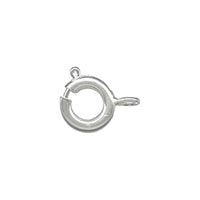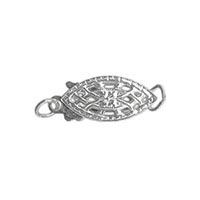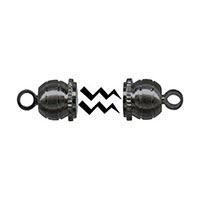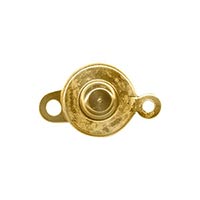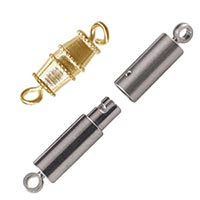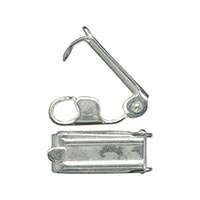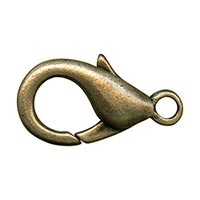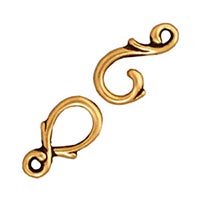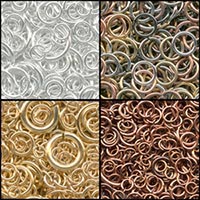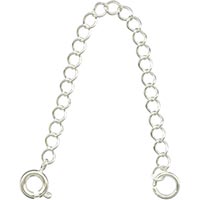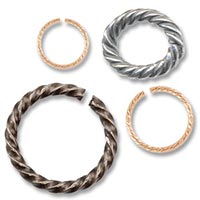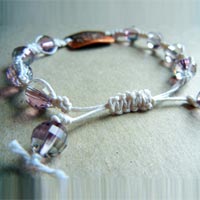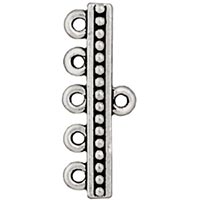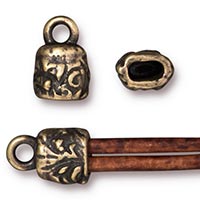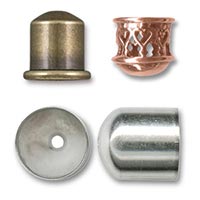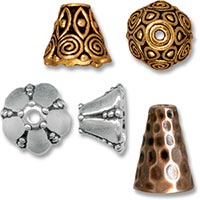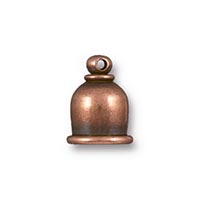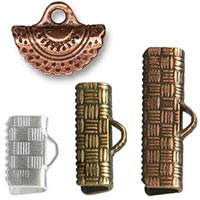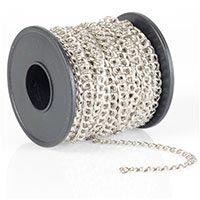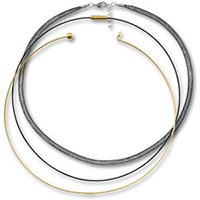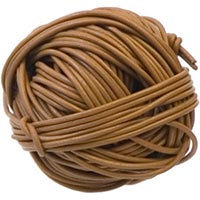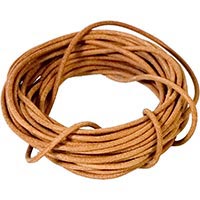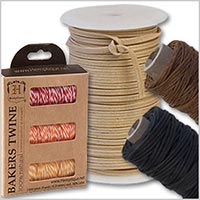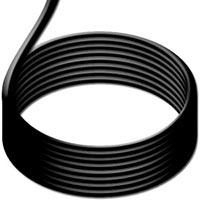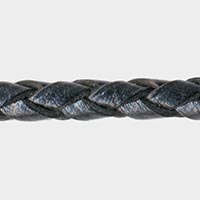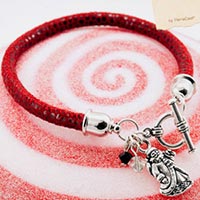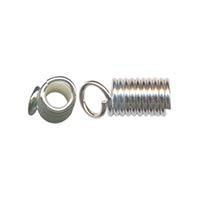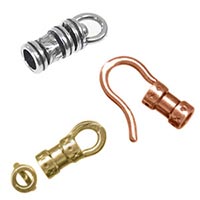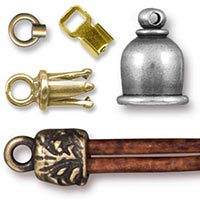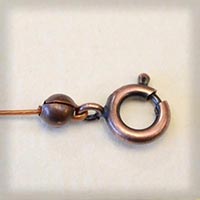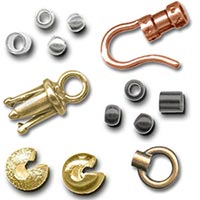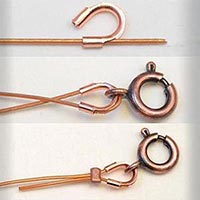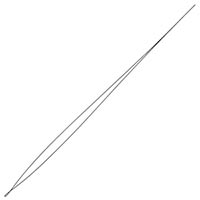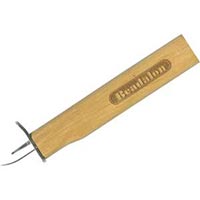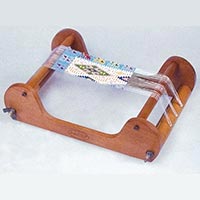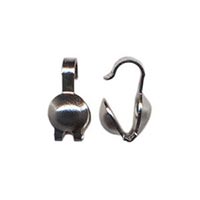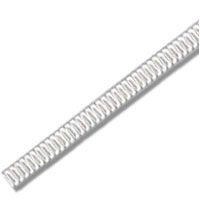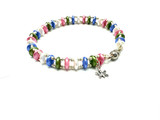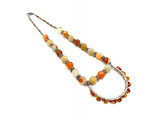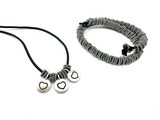Choosing Clasps & Finishing Methods
Are you asking yourself "What clasp should I use for my bead stringing, wire lashing, kumihimo, multi-strand, chunky chain, awesome creation?" There are 100's of options, and the "correct" answer is based on the weight and type of jewelry, as well as your personal preference and the stringing material(s) you choose. Find brief answers and illustrations here, with links to jewelry-making findings and supplies.
Get more how-to tips with our free guides to finishing methods and stringing materials for handmade jewelry.
Choosing a Clasp
Size Considerations: Choose size of clasp according to weight and size of jewelry, so a heavy clasp doesn't overwhelm a tiny piece of jewelry, or so a tiny clasp doesn't break or pull open on a heavy piece of jewelry. We list the size of most clasps in the name, with more specific size details if you click into the product or use the "Compare Products" feature of our website.
Hand Strength and Dexterity: Some clasps are easier to clasp with one hand, or with limited dexterity. (More details about this, listed with each relevant clasp option.)
Security: Some clasps rely on the weight or tension of the jewelry, to keep the clasp closed. Avoid toggle clasps and hook & eye clasps with lightweight, loose-fitting jewelry.
- Spring rings are inexpensive and light weight, and available in all materials and platings. They can be a little tough to hook one-handed, so are more popular for necklaces, than bracelets. At the other end of the strung design, use a jump ring or chain tab to hook the spring ring into. This is the style of clasp you'll find on most fine (lightweight) pre-made necklace chains.
- Pearl clasps are extra-secure filigree box clasps, usually oval or marquise in shape. They don't require fingernails, but they do generally require 2 hands to open and close, so they are best for necklaces. They are often used for knotted pearls strung on silk beading cord, finished with bead tips or bullion.
- Magnetic clasps have a sleek design that looks good on a wide variety of jewelry. Our Superior Quality Mag-Lok clasps are suitable even for heavy jewelry. Most people find that they can't pull our superior quality Mak-Lok or TierraCast magnetic clasps straight apart, and have to "twist-slide" them open. Our standard magnetic clasps are best for lighter jewelry. People with severe arthritis often love our standard magnetic clasps, but use caution when using a standard magnetic clasp with expensive jewelry.
- Snap clasps are nice for people who have a tough time with lobster clasps and spring rings. You "pop" them open and closed like a snap. They are best for lighter weight designs and can be used for both necklaces and bracelets.
- Barrel clasps definitely require 2 hands (so they are best for necklaces), and people generally either love them, or hate them. Some jewelry wearers swear these are the only type of clasp they can successfully open and close, and others never get the twisting motion down.
- Fold-Over clasps are popular for bracelets, because they can be opened and closed with one hand.
- Lobster clasps have a sleek look and are available in a wide variety of sizes, materials and platings. They are usually a little larger (heavier) than spring rings, so are best for slightly heavier jewelry. Some lobster clasps are very large and strong, and are suitable for masculine designs, and very chunky or heavy jewelry. "Triggerless" and "Double Push" lobster clasps (only available in sterling silver) are nice for people who break fingernails on conventional lobster clasps and spring rings.
- Toggle clasps can be hooked with one hand, so are popular for bracelets as well as necklaces. They are available in a wide variety of sizes and materials, and are sometimes used as the focal at the front of a necklace. Toggle clasps are very popular, but there are 2 design considerations to remember when using a toggle clasp:
1. Always test to make sure the last few beads (or links) near the "T" part of the clasp (the bar) are small enough that you can easily pull the bar through the loop, to close the clasp.
2. When using a toggle clasp for a bracelet, make sure the bracelet fits a bit snug, so the toggle can't accidentally open. It doesn't need to be uncomfortably tight; just make sure there is not too much slack. - Hook and eye clasps are best for heavier necklaces or tight-fitting bracelets, so the weight of the necklace, or the tension of the bracelet or choker, helps keep the clasp secure. S-Hooks (or S-Clasps) are also a form of hook & eye clasps. Some hook clasps have a crimp end, for attaching directly onto your cording. We'll get to those in a moment...
The "Other Half" ...
Spring rings, lobster clasps, fold-over clasps and some hook clasps require you to choose a ring to use for the other end of the necklace or bracelet. Medium to large jump rings are the most popular, and jump ring mixes are great options if you're not sure what size will look best. Soldered/solid jump rings and split rings (like tiny key rings), are also popular options for this "other half", and if you really want to get creative, there is a nearly-infinite variety of other link and connector options.
Adjustable Jewelry
Adjustable necklaces, bracelets and anklets with spring rings, lobster clasps, toggle clasps or fold-over clasps can be achieved by using a section of chain or a few extra links or rings of the proper size to hook the clasp into. Another option is to make an extender chain (with the same type of clasp as your strung design), or buy a ready-made chain extender.
For heavy cord such as 1mm and thicker leather, cotton, etc., you can avoid the clasp altogether and use an adjustable knot (illustration coming soon ... ish). While we're looking for that illustration, here's a link to our blog article on creating adjustable bracelets using square knots (aka macramé):
How to Attach a Clasp to the Stringing Material
The method and supplies required for attaching clasps to bracelets, necklaces and anklets depend primarily on the type of cord or stringing material. First let's discuss a few specialty variables that can affect your decision.
Multistrand and Braided Jewelry:
Multistrand jewelry can be simple, or can require special supplies. A few popular options include:
- Use a multistrand clasp, and attach each strand directly to a loop on the clasp (using a jump ring, or one of the other finishing methods listed below).
- For a similar style with a little more flexibility, use multistrand necklace ends and the clasp of your choice. This generally works with 2-strand, 3-strand, 4-strand and 5-strand strung designs. Using spacer bars in combination with multistrand necklace ends keeps all your strands nicely spaced apart.
- For two strands of 2mm round leather or cotton, TierraCast's crimp end cap with loop works great.
What if you have more than 5 strands, or you want to bundle them all together and cover up the end?
- Collect all your strands into a bullet end or cone end, and create a wire loop to attach to the clasp of your choice. Bullet ends and cone ends work best for materials that you can knot securely or wrap with wire. Bullet ends are great for hiding messy-looking, strong knots.
- Collect all your strands into a cord end with loop and secure them there with glue. This is the most popular finishing method for Kumihimo and other braided, crocheted, or wire-knit multistrand designs.
Chokers:
Use your choice of clasp, based on personal preference and the criteria above. If using flat ribbon, or suede or leather strips (straps) for your choker, finish the ends with choker clamps and (optional) a section of chain that the clasp can hook into to make the necklace adjustable. Another option is to go with ready-made choker blanks and semi-finished chokers.
Finishing Methods For Leather Cord, Cotton Cord and other Large Round Cording:
Coil Ends, Center-Crimp Cord Ends, and Glue-On Cord Ends are popular options for finishing 1mm, 1.5mm, 2mm and 3mm leather cord, cotton cord, rubber cord and similar large round stringing materials.
- Coil Ends are inexpensive and easy to use. Whenever possible, we recommend doubling the end of your cord (just a few millimeters worth, about 1/4") before inserting it. It can help to twist the cord as you push it into the cord (see illustration). You can add a dab of glue, but it's not usually necessary. Take a pair of flat needle-nose pliers and firmly crimp the last leg of the coil down to hold the cord in place. Then use a jump ring to attach the the loop to the clasp of your choice.
- Center-Crimp Cord Ends work nearly the same way. Pick a center-crimp that matches your cording size, insert the cord, and then firmly crimp the center section with narrow chain-nose or round-nose pliers. Pair up one center crimp with loop and one center crimp with hook to create a full hook and eye clasp. Or, use two center crimps with loop (one on each end of your cord), then add any clasp of your choice.
- Glue-On Cord Ends are best for materials like rubber and rattail (that are too soft to crimp), and for braided or larger cord like bolo cord and 6mm round suede cord. Use a glue that's safe for your type of material, and then use jump rings to attach the clasp of your choice. Glue-On Cord Ends are available in sizes ranging from 1.7mm (perfect for rubber tubing), to 10mm inner diameter.
Finishing Methods for Fishing Line:
We don't recommend fishing line for stringing jewelry, especially if you're selling your jewelry. While it can be strong to begin with, most fishing line has a limited lifespan and will break after enough wear, due to abrasion or exposure to sunlight (UV rays). However, if fishing line is what you have, and you need to figure out how to attach your strung designs to a clasp (without just tying chunky knots), you can use nearly any of the beading wire or beading thread finishing methods recommended below. If you like the clarity of of fishing line, then you'll love clear Supplemax! It's strong and clear, ideal for illusion necklaces, bridal jewelry, and hair adornments. It is not stretchy, and does not require a needle. You can secure the ends with knots, superglue, or 2mm crimp beads.
Finishing Methods for Beading Wire (Stringing Cable):
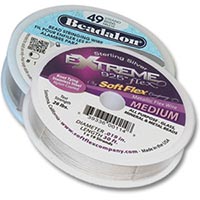 Beading Wire (also called Stringing Cable or Tigertail) is one of the most popular stringing materials, because it's strong and easy to use. It's stiff enough that you don't need a needle (yay!), yet thin enough to use with nearly all glass, crystal, gemstone and pearl beads. It's available in a wide variety of strengths, thicknesses and amounts of flexibility, so you can use it for everything from fine bead-weaving to heavy, abrasive metal trade beads. Not sure what size to get? 0.018" or 0.019" diameter is the middle weight, and a good size for most general bead stringing. (To determine the ideal weight for your exact stringing project, you may need to click into the product details for a few of the sizes/styles.) Soft Flex and Beadalon are the biggest names in beading wire. Like Coke and Pepsi, they are similar, but those who are familiar with both, have strong favorites. Soft Flex, as you might guess from the name, is the more flexible of the two.
Beading Wire (also called Stringing Cable or Tigertail) is one of the most popular stringing materials, because it's strong and easy to use. It's stiff enough that you don't need a needle (yay!), yet thin enough to use with nearly all glass, crystal, gemstone and pearl beads. It's available in a wide variety of strengths, thicknesses and amounts of flexibility, so you can use it for everything from fine bead-weaving to heavy, abrasive metal trade beads. Not sure what size to get? 0.018" or 0.019" diameter is the middle weight, and a good size for most general bead stringing. (To determine the ideal weight for your exact stringing project, you may need to click into the product details for a few of the sizes/styles.) Soft Flex and Beadalon are the biggest names in beading wire. Like Coke and Pepsi, they are similar, but those who are familiar with both, have strong favorites. Soft Flex, as you might guess from the name, is the more flexible of the two.
- Crimp beads are the normal way to finish Beadalon and Soft Flex beading wire (stringing cable). Just string on a crimp, add your clasp or other specialty findings, make a loop with your beading wire, and put the end of the loop back through your crimp bead. Then, either flatten the crimp bead with flat-nose jewelry pliers, or use crimping pliers to create a smaller, rounded crimped bead.
- For a more professional-looking finish, you may cover the crimp bead with a crimp cover, and/or cover the stringing cable with French wire (bullion).
- For heavy designs, or strung designs that will get a lot of wear or abuse, a wire protector (aka cable thimble or wire guard) is a good idea.
Beading Thread:
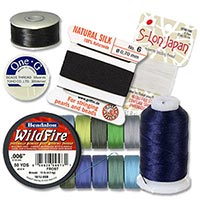 There are many types of beading thread, and each has its pros and cons. Some are better for beadweaving than bead stringing, and some have weights that work for both. Some are stretchy, some guarantee no stretch. When stringing beads, you want the thickest (most durable) cord that easily passes through all your beads. Pearls and 2-3mm faceted gemstone beads are notorious for having tiny holes, and generally require the thinner sizes of Needle-end silk cord, so you don't have to worry about threading a tiny-eyed needle. Beadweavers use very thin diameters of thread and synthetic cord, because they frequently use tiny seed beads, plus go back and forth through each bead hole multiple times. Synthetic cords are less likely to fray when going through beads multiple time. Waxed cords generally knot tighter than synthetic cord. Silk cord is normally the favorite for traditional knotted pearl necklaces.
There are many types of beading thread, and each has its pros and cons. Some are better for beadweaving than bead stringing, and some have weights that work for both. Some are stretchy, some guarantee no stretch. When stringing beads, you want the thickest (most durable) cord that easily passes through all your beads. Pearls and 2-3mm faceted gemstone beads are notorious for having tiny holes, and generally require the thinner sizes of Needle-end silk cord, so you don't have to worry about threading a tiny-eyed needle. Beadweavers use very thin diameters of thread and synthetic cord, because they frequently use tiny seed beads, plus go back and forth through each bead hole multiple times. Synthetic cords are less likely to fray when going through beads multiple time. Waxed cords generally knot tighter than synthetic cord. Silk cord is normally the favorite for traditional knotted pearl necklaces.
- Needle-end silk cord is popular for stringing gemstones and pearls, and works great for most glass and metal beads, too. There is a flexible brass needle built into one end of the cord, so you don't need to worry about finding a needle the right size, or threading a tiny beading needle. Bead tips are the most popular way to finish the ends of necklaces and bracelets strung on silk cord, and bullion is an attractive but less common material for finishing the ends.
- Size E silk beading thread is excellent for stringing all types of beads, and is especially popular for stringing gemstone necklaces (with or without knotting between the beads). All our sizes of twisted steel wire needles work great with it. Ends are normally finished with bead tips and/or bullion.
- Size FF Nylon No-Stretch Bead Cord can be used with size 10 or twisted-wire needles, or you can simply stiffen the end with superglue. Size FF is about the same size as Size 6 needle-end nylon cord, which is a nice size for stringing most materials, including standard Czech glass beads.
- Super-Lon (or S-Lon) comes in a rainbow of pretty colors, and we stock it in 2 sizes: Size D (0.3mm, which is very fine, normally used for bead weaving), and size #18 (0.5mm), which is great for stringing, bead crochet, micro-macrame and kumihimo braiding.
- Our Nymo Beading Thread: Size 0 (0.15mm) is very fine, and is best for beadwork (on or off loom), rather than traditional strung designs. Use with a size 15 or fine twisted-wire needle. Size D (0.3mm) is popular for stringing all types of glass beads, plus is used for beadwork, and beadweaving with larger seed beads.
- Power Pro was a very nice waxed braided bead thread, but it's out of production. It is (was) just stiff enough, that no needle was required when using it for bead stringing.
- Wildfire is ideal for working with seed beads, especially for beadweaving, as it doesn't fray and can't be pierced with a needle.
- Clear SuppleMax is strong and clear, ideal for illusion necklaces, bridal jewelry, and hair adornments. It is not stretchy, and does not require a needle. You can secure the ends with knots, superglue, or 2mm crimp beads.
- Stretch Magic is clear stretchy cord. It's soft and flexible, yet strong and UV resistant, and is available in 0.5mm, 0.7mm and 1.0mm thicknesses. (Some sizes are also available in black ... the black is not clear). It's normally finished with knots, but you can also crimp it, using special crimp tubes designed for stretch cord. Gossamer Floss and Elonga Cord are two styles of super-stretchy, shimmery multi-strand cord. Both are wonderful for stretchy bracelets.
- Bead tips are jewelry findings that provide a great way to hide knots at the ends of bead thread. To use a bead tip, thread the end of your stringing material through the hole, then knot it, to secure your strand. If your thread is very thin, you might want to tie the knot around a seed bead, to give your knot some extra bulk, preventing the knot from pulling back through the hole. After your knot is secure, attach the bead tip's hook or loop directly to your clasp, or use a jump ring to connect the bead tip to your clasp.
- Bullion (aka French Wire) is a beautiful way to finish high-end jewelry strung on beading thread. It protects and hides the thread at the end of your necklace. But working with it requires a delicate touch, so it's not for everyone.
This concludes the most commonly-used stringing materials and their preferred finishing methods. Looking for something else? Try these additional resources:
- Browse our Guide to Jewelry Stringing Materials for descriptions and links... actually, right now, this info is at the bottom of of our main Stringing page, and we're re-organizing it to fit into our website upgrade.
- Click into any product's details in the Jewelry Stringing Materials section of our website. If we don't have enough info there for you, please leave a Product Review asking how to use the item.
- Download and print our Free Jewelry Making Technique Sheets.
- Search our Blog at https://blog.rings-things.com.
- Sign up for our email news. We normally send an email with new jewelry projects every Friday. If we don't include the tips & techniques you're looking for, just reply and ask for help! Your questions help us decide what types of new jewelry to create.
p.s. Bead Stoppers are awesome! They aren't a finishing method, and they might sound (or look) silly at first, but if you do a lot of bead stringing, you'll love them.
Our Bead Blog
-
Simply Springy 2-Hole Bracelet
Apr 28th 2025Designed by: Guest Designer Deb Floros Suggested Supplies 1 #61-840-50-01 Beadalon Cord, WildFire,
-
Exotic Statement Necklace
Apr 28th 2025Designed by: Guest Designer Deb Floros Suggested Supplies 1 #88-400-003-5 58x50mm Pewter Connector,
-
Rubber Tubing Necklace and Memory Wire Bracelet Set
Mar 21st 2025Designed by: Guest Designer Deb Floros Suggested Supplies 1 #61-622-02 2mm Rubber Cord, Bulk, for J

